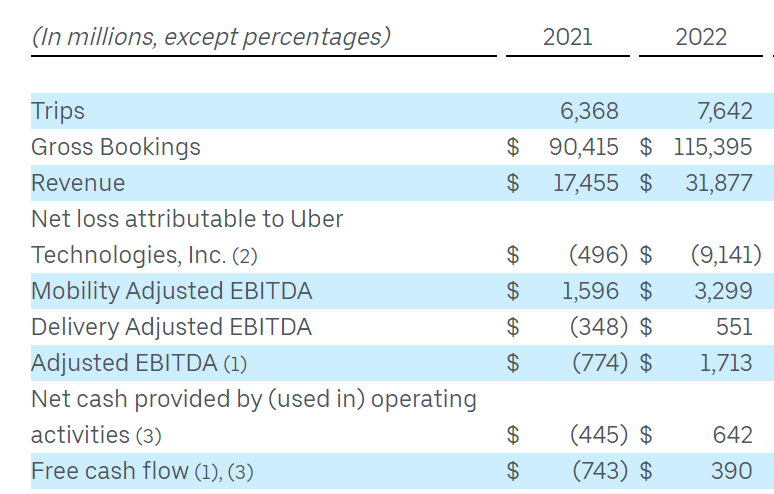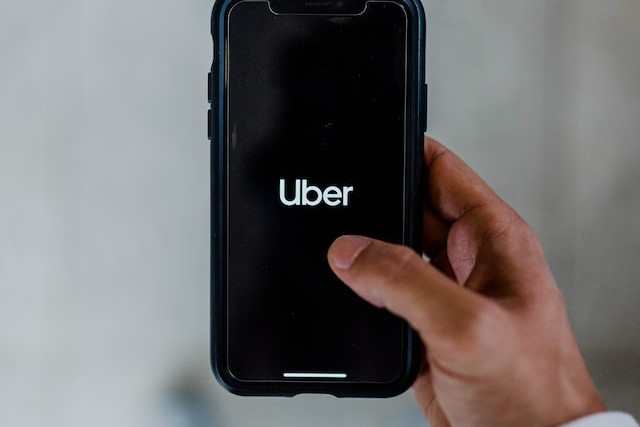Before we dive deep into the SWOT analysis, let’s get the business overview of Uber. Uber Technologies Inc. is a multinational ride-hailing company based in San Francisco, California. It develops and operates various businesses across more than 70 countries worldwide.
As of 2022, here are the core components of Uber’s business:
- Ride-hailing: Uber’s ride-hailing service allows customers to request rides from registered drivers through a mobile app. It offers different service levels ranging from budget options like UberX and UberPool to luxury options like UberBlack and UberLux.
- Uber Eats: This is Uber’s food delivery service. Customers can order from various restaurants and deliver their food by Uber Eats drivers.
- Uber Freight: This service connects shippers with truckers, much like the ride-hailing service does with drivers and riders, but for large-scale freight instead.
- Advanced Technologies Group (ATG): Uber’s team is working on self-driving technology to build autonomous cars and trucks for the Uber network. The goal is to increase safety and efficiency while reducing costs. However, this part of the business has faced numerous challenges and controversies.
- Uber Health: This service provides patient transportation for healthcare providers. It is HIPAA-compliant and is meant to assist those who may not have easy transportation access to their medical appointments.
- Uber Business: This service caters to businesses by providing a platform for employee travel, customer rides, and food delivery for employees. It offers tools for managers to set rules for employees, customers, and clients to use Uber and Uber Eats.
- Bike and Scooter Rentals: In certain cities, Uber offers electric bike and scooter rentals for short trips.
Uber operates on a gig economy model, with drivers and couriers working as independent contractors, not employees. This has been a point of contention and legal dispute in several jurisdictions.
Uber’s business model is a multi-sided platform that connects drivers and passengers, restaurants and customers, and shippers and carriers, creating value for all participants. However, Uber has faced criticism and legal challenges regarding worker rights, safety, competitive practices, and other issues.
Uber drivers completed 7.6 billion trips in 2022, and Uber has a 68% market share in the US.
Financial Performance: In 2022, Uber generated a revenue of $31.9 bn with a net loss of $9.1 bn. More details are presented below:

How does Uber work & make money | Business Model
Here is the SWOT analysis for Uber
A SWOT analysis is a strategic planning tool used to evaluate the Strengths, Weaknesses, Opportunities, and Threats of a business, project, or individual. It involves identifying the internal and external factors that can affect a venture’s success or failure and analyzing them to develop a strategic plan. In this article, we do a SWOT Analysis of Uber.
SWOT Analysis: Meaning, Importance, and Examples
Strengths
Some strengths of Uber as a company include the following:
- Large user base: Uber has a massive user base, with millions of people using its platform to hail rides every day. This gives the company a strong position in the ride-hailing market and provides a network effect that helps to keep users loyal to the platform.
- Extensive global presence: Uber operates in over 700 cities worldwide, giving it a significant advantage over its competitors in terms of reach and scalability.
- Technological innovation: Uber has been at the forefront of technological innovation in the ride-hailing industry, introducing features like real-time tracking, cashless payments, and driver ratings. This has helped to create a seamless user experience that is easy to use and highly efficient.
- Diverse range of services: In addition to its core ride-hailing service, Uber has also expanded into other areas, such as food delivery and bike-sharing, giving it multiple revenue streams and further diversifying its business model.
- Strong brand recognition: Uber is one of the most well-known ride-hailing companies in the world, with a strong brand that is widely recognized and trusted by consumers. This gives the company a competitive advantage over newer and less established players in the market.
Weaknesses
Some weaknesses of Uber as a company include the following:
- Controversies and legal challenges: Uber has faced several controversies and legal challenges, including allegations of sexual harassment, discrimination, and regulatory violations. These issues have hurt the company’s reputation and led to increased scrutiny from lawmakers and the public.
- Dependence on drivers: Uber relies on a large number of drivers to provide its core ride-hailing service. This creates a risk for the company, as drivers may become dissatisfied with their working conditions or leave the platform for other opportunities, which could lead to a shortage of available drivers.
- Vulnerability to external factors: Uber’s business is vulnerable to external factors such as economic downturns, regulatory changes, and consumer preferences. For example, a recession or new regulations could significantly impact the company’s profitability and growth prospects.
- Lack of profitability: Uber has struggled to generate consistent profits despite its large user base and global presence. The company has invested heavily in new technologies and expansion into new markets, which has resulted in significant losses over the years.
- Competition: The ride-hailing industry is highly competitive, with several other companies vying for market share. Uber faces intense competition from companies such as Lyft, Didi Chuxing, and Grab, which could impact its growth and profitability over the long term.
Lyft Business Model: Improving lives through transportation
Opportunities
Some opportunities for Uber as a company include:
- Expansion into new markets: Uber can continue expanding into new markets, both domestically and internationally. This could allow the company to increase its user base and revenue streams and diversify its business model.
- Innovation in autonomous vehicles: Uber has been investing heavily in autonomous vehicle technology, which could have significant implications for the ride-hailing industry. If successful, this could reduce the company’s dependence on drivers and improve efficiency and profitability.
- Partnering with other companies: Uber can partner with other companies to expand its offerings and reach new customers. For example, the company has already partnered with major brands such as McDonald’s and Spotify to offer integrated services.
- Expansion into other transportation services: In addition to ride-hailing and food delivery, Uber has the opportunity to expand into other transportation services such as public transit, bike-sharing, and electric scooters. This could help the company to capture new revenue streams and become a more comprehensive transportation platform.
- Growing demand for ride-hailing: As urbanization continues to increase and car ownership becomes less common, there is likely to be a growing demand for ride-hailing services. Uber can capitalize on this trend and become the dominant player in the ride-hailing industry.
Threats
Some threats to Uber as a company include:
- Competition from other ride-hailing services: Uber faces intense competition from other ride-hailing services, both domestically and internationally. This competition could lead to price wars, hurting the company’s profitability and growth prospects.
- Increased regulation: Governments and regulatory bodies worldwide are increasingly imposing new regulations on ride-hailing services, which could impact Uber’s ability to operate and compete in certain markets.
- Negative public perception: Uber has faced several controversies in recent years, which have hurt the company’s reputation and led to negative public perception. This could impact the company’s ability to attract and retain new customers.
- Cybersecurity threats: As a technology-driven company, Uber is vulnerable to cybersecurity threats like data breaches and hacking attacks. These threats could lead to significant financial and reputational damage.
- Economic downturns: Uber’s business is highly dependent on the economy’s overall health. If there is an economic downturn or recession, demand for ride-hailing services could decline, impacting the company’s revenue and profitability.









